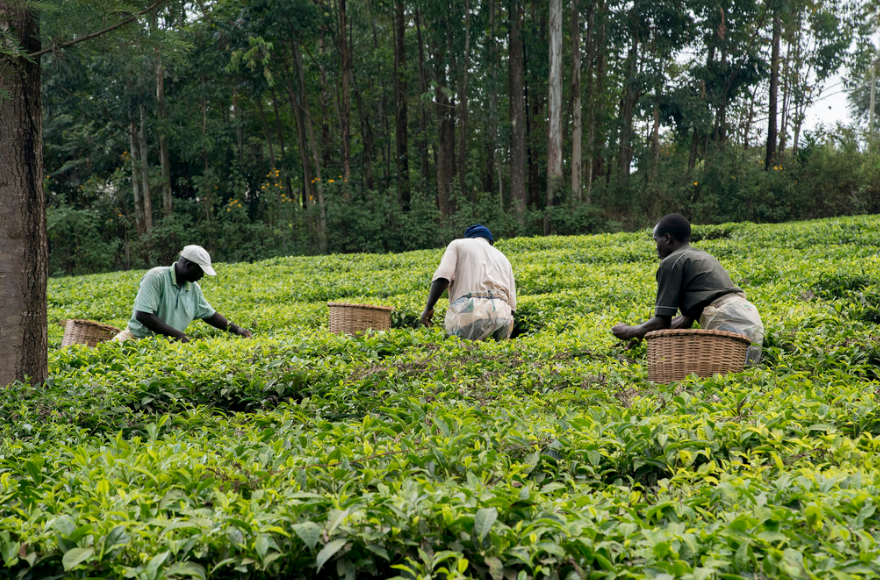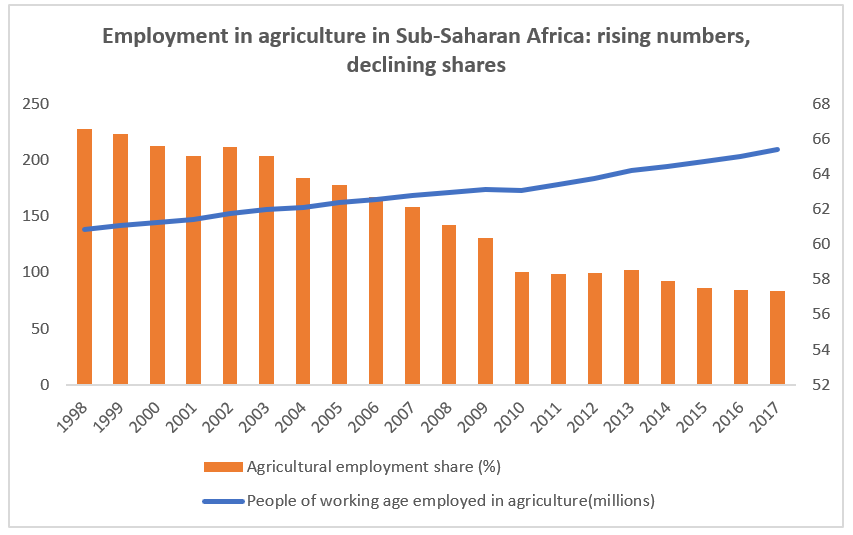Many people in Sub-Saharan Africa still work in agriculture; on average, over half of the labor force, and even more in poorer countries and localities. Yet the share of the labor force in agriculture is declining (as is normal in development), leading African leaders and economists to focus on job creation outside agriculture.
Planning for jobs of the future matters. The 200 million young people (those ages 15-24 years old) either looking for jobs or constructing livelihoods now, will increase to 275 million each year by 2030, and 325 million by 2050. Is the neglect of agriculture in job creation strategies and public investments premature?

Is the neglect of agriculture in job creation strategies and public investments premature? Photo: Peter Kapuscinski / World Bank
Declining shares, rising numbers
In the early phases of the structural transformation, where most African countries currently are, agriculture absorbs labor. This has been true and documented historically: Taiwan in the mid-20th century; China from 1978-1990; in India until 2005; Vietnam until 2014. Agriculture in Africa is also absorbing labor now (Figure below). The agricultural labor shares decline; yet the absolute numbers of people employed in agriculture still increase. This remains an underappreciated stylized fact of structural transformation.
Following historical experience, the absolute numbers in Africa are expected to rise for another several decades before they come down. In each of these historic instances, the “absolute increase and relative decline” of the labor force in agriculture coincided with rapid growth in agricultural productivity and concurrent expansion of services and labor-intensive manufacturing.
That Africa’s agricultural labor force continues to rise in numbers while the share declines is therefore not anomalous. Quite the opposite—an absolute net flow of labor out of agriculture would be extraordinary given the size of the agricultural labor force relative to the receiving sectors of services, construction, manufacturing and mining. Even as these sectors grow and absorb labor, they are not yet large enough to support a net reduction in number of people employed in agriculture.
The period of absolute increase and relative decline in Africa’s agricultural labor force is likely to be prolonged given Africa’s slow demographic transition and the associated slow per capita income growth. Out of the slightly larger than 3 percentage points annual increase in Sub-Saharan Africa’s demand for food (in volume), about 2.6 points still come from population growth; the remainder from urbanization and income growth.
As incomes rise, the share of income going to food further declines, the demand for non-food goods and services increases more rapidly, and farm exits accelerate. This productively frees up labor for non-agricultural production, at least if agricultural labor productivity also increases.
What to do?
Recognition of “absolute growth with relative decline” of the agricultural labor force in the coming decades in Sub-Saharan Africa requires adjusting strategies on job creation. A climate resilient labor-absorbing agricultural transformation will have to be part of Africa’s foreseeable future. Productivity growth, including labor productivity, is essential to success.
Good management requires foresight and a willingness on the part of national and international leaders to invest not only in the education and health of rural young people, but also in the sector that will in many cases be their major employer. Resources will need to flow into agricultural science and rural infrastructure on a scale greater than is happening today. Without such investment and with climate change intensifying, the countries and regions that will house millions of rural young people in 2030 and 2050 will face unmitigated downside risk. Their agricultural competitiveness will further erode as wealthier and more diversified economies adapt faster and encroach on local and regional food markets.
Such a gloomy future is neither desirable nor necessary. While the agriculture sector’s share of the labor force declines, the number of farmers and farm workers will continue to grow for some time. Their welfare will also increase if the public sector makes the investments needed to raise agricultural labor productivity.
This blog was originally published on the World Bank's Jobs and Development Blog. Luc Christiaensen is a lead agriculture economist in the World Bank’s Jobs Group and an honorary research fellow at the Maastricht School of Management. Karen Brooks is a former director of the CGIAR Research Program on Policies, Institutions, and Markets (PIM) and a former Sector Manager, Agricultural Operations, Africa Region, The World Bank.
Also read:
In focus: Jobs in agriculture for young people
Agricultural science can speed job creation for youth in Africa South of the Sahara
Foresight Africa viewpoint: Science and the farm



